Get the simplified Class 6 Maths NCERT Solutions of Ganita Prakash Chapter 2 Lines and Angles textbook exercise questions with complete explanation.
Ganita Prakash Class 6 Maths Chapter 2 Solutions Lines and Angles
NCERT Solutions for Class 6 Maths Ganita Prakash Chapter 2 Lines and Angles
2.1 Point 2.2 Line Segment 2.3 Line 2.4 Ray Figure it Out (Page No. 15-17)
Question 1.
Rihan marked a point on a piece of paper. How many lines can he draw that pass through the point?
Sheetal marked two points on a piece of paper. How many different lines can she draw that pass through both of the points?
Can you help Rihan and Sheetal find their answers?
Solution:
Infinite number of lines can be drawn to pass through a point in a plane.
One and only one line can be drawn to pass through two points.
Question 2.
Name the line segments in Fig. below. Which of the five marked points are on exactly one of the line segments? Which are on two of the line segments?

Solution:
Line segments: LM, MP, PQ and QR
Points L and R are on one line segment only. Points M, P and Q are on two line segments.
Question 3.
Name the rays shown in Fig. below. Is T the starting point of each of these rays?

Solution:
Ray \(\overline{\mathrm{TA}}\) and ray \(\overline{\mathrm{TB}}\) (can be also called ray TN). Yes, T is the starting point of each of the 2 rays, \(\overline{\mathrm{TA}}\) and \(\overline{\mathrm{TB}}\).
![]()
Question 4.
Draw a rough figure and write labels appropriately to illustrate each of the following:
(a) \(\overline{\mathrm{OP}}\) and \(\overline{\mathrm{OQ}}\) meet at O.
Solution:
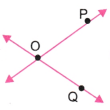
(b) \(\overline{\mathrm{XY}}\) and \(\overline{\mathrm{PQ}}\) intersect at point M.
Solution:

(c) Line l contains points E and F but not point D.
Solution:

(d) Point P lies on AB.
Solution:

Question 5.
In Fig. below name:

(a) Five points
(b) Aline
(c) Four rays
(d) Five line segments
Solution:
Points B, C, D, E and O.
Line: DB
Rays: \(\overrightarrow{\mathrm{OB}}, \overrightarrow{\mathrm{OC}}, \overrightarrow{\mathrm{OD}} ; \overrightarrow{\mathrm{OE}}\)
Line segments: DE, EO, OB, DC, DO.
Question 6.
Here is a ray \(\overrightarrow{\mathrm{OB}}\) (Fig.). It starts at O and passes through the point A. It also passes through the point B.
(a) Can you also name it as \(\overrightarrow{\mathrm{OB}}\)? Why?
(b) Can we write \(\overrightarrow{\mathrm{OA}}\) as \(\overrightarrow{\mathrm{AO}}\) ? Why or why not?
Solution:
(a) Yes, Ray \(\overrightarrow{\mathrm{OA}}\) can also be named as ray \(\overrightarrow{\mathrm{OB}}\) as initial point and direction remains same.
(b) Ray \(\overrightarrow{\mathrm{OA}}\) cannot be named as ray \(\overrightarrow{\mathrm{AO}}\) as the initial point of the ray is O, not A.
![]()
2.5 Angle Figure it Out (Page No. 19-21)
Question 1.
Can you find the angles in the given pictures? Draw the rays forming any one of the angles and name the vertex of the angle.
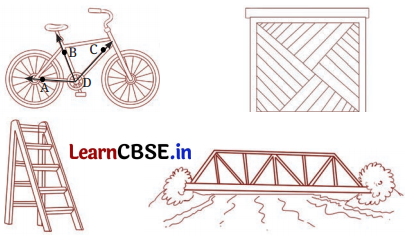
Solution:
(a) ∠ADB, ∠BDC, vertex: D
(b) ∠PQR, vertex: Q

(c) ∠LMN, vertex: M

(d) ∠XYZ, vertex: Y

Question 2.
Draw and label an angle with arms ST and SR.
Solution:

Question 3.
Explain why ∠APC cannot be labelled as ∠P.

Solution:
Sol. At P there are three angles.
∠P could mean ∠APB or ∠BPC or ∠APC.
To get the correct angle, it has to be named as ∠APC or ∠APB or ∠BPC.
Also note that a single point can not form an angle.
Question 4.
Name the angles marked in the given figure.

Solution:
Angles in the figure are :
Angle 1 is ∠RTP
Angle 2 is ∠RTQ
![]()
Question 5.
Mark any three points on your paper that are not on one line. Label them A, B, C. Draw all possible lines going through pairs of these points. How many lines do you get? Name them. How many angles can you name using A, B, C? Write them down, and mark each of them with a curve as in Fig. (SeeNCERT Textbook,page 18).
Solution:

We get three lines.
These are line AB, line BC and line CA.
Also, we get three angles.
These are ∠ABC, ∠BCA and ∠CAB.
Question 6.
Now mark any four points on your paper so that no three of them are on one line. Label them A, B, C, D. Draw all possible lines going through pairs of these points. How many lines do you get? Name them. How many angles can you name using A, B, C, D? Write them all down, and mark each of them with a curve as in Fig. (See NCERT Textbook, page 18).
Solution:

We get six lines.
These are line AB, line BC, line CD, line DA, line AC and line BD.
Also, we get twelve angles.
These are ∠BAC; ∠CAD, ∠BAD, ∠ABD, ∠DBC, ∠ABC, ∠BCA, ∠ACD, ∠BCD, ∠CDB, ∠CDA, ∠BDA.
2.6 Comparing Angles Figure it Out (Page No. 23)
Question 1.
Fold a rectangular sheet of paper, then draw a line along the fold created. Name and compare the angles formed between the fold and the sides of the paper. Make different angles by folding a rectangular sheet of paper and compare the angles. Which is the largest and smallest angle you made?

Solution:
Let’s mark the rectangle and vertex of the fold as shown in figure below.
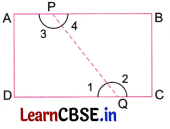
We get ∠1, ∠2, ∠3 and ∠4.
Comparing: ∠1 < ∠2, ∠4 < ∠3,
∠1 = ∠4, ∠2 = ∠3.
∠2 and ∠3 are the largest angles.
∠1 and ∠4 are the smallest angles.
Question 2.
In each case, determine which angle- is greater and why.

(a) ∠AOB or ∠XOY
(b) ∠AOB or ∠XOB
(c) ∠XOB or ∠XOC
Discuss with your friends on how you decided which one is greater.
Solution:
(a) ∠AOB > ∠XOY
(∠AOB has more spread than ∠XOY)
(b) ∠AOB > ∠XOB
(∠AOB has more spread than ∠XOB)
(c) ∠XOB = ∠XOC
(B and C are points on same ray; both angles have same arms and vertex, hence same spread)
Question 3.
Which angle is greater: ∠XOY or ∠AOB? Give reasons.

Solution:

∠1 > ∠3
(∠1 has more spread than ∠3)
∠1 + ∠2 > ∠3 + ∠2
(adding ∠2 to both sides)
Hence, ∠XOY > ∠AOB
![]()
2.7 Making Rotating Arms 2.8 Special Types of Angles Figure it Out (Page No. 29-31)
Question 1.
How many right angles do the windows of your classroom contain? Do you see other right angles in your classroom?
Solution:
A window has 4 right angles.
∠1, ∠2, ∠3 and ∠4.
Yes. At comers of door. At comers of blackboard etc.

Question 2.
Join A to other grid points in the figure by a straight line to get a straight angle. What are all the different ways of doing it?

Solution:

This can be done in one way.
Question 3.
Now join A to dther grid points in the figure by a straight line to get a right angle. What are all the different ways of doing it?

Hint: Extend the line further as shown in the figure below. To get a right angle at A, we need to draw a line through it that divides the straight angle CAB into two equal parts.

Solution:

![]()
Question 4.
Get a slanting crease on the paper. Now, try to get another crease that is perpendicular to the slanting crease.
(a) How many right angles do you have now? Justify why the angles are exact right angles.
Solution:
We get four right angles.
Let P be the point of intersection of the two creases.
The two creases are perpendicular lines meeting at P.
Hence, all four angles are right angles.

(b) Describe how you folded the paper so that any other person who doesn’t know the process can simply follow your description to get the right angle.
Solution:

Step 1. Take a sheet of paper and fold it. Step 2. Crease the fold.
Step 3. Now again fold the paper so that the two parts of the crease coincide.
Step 4. Crease the fold.
Step 5. Unfold both the creases.
We get two perpendicular lines and four right angles as shown above.
2.7 Making Rotating Arms 2.8 Special Types of Angles Figure it Out (Page No. 31-32)
Question 1.
Identify acute, right, obtuse and straight angles in the given figures (See NCERT TB, Page 31).
Solution:

Question 2.
Make a few acute angles and a few obtuse angles. Draw them in different orientations.
Solution:

Question 3.
Do you know what the words acute and obtuse mean? Acute means sharp and obtuse means blunt. Why do you think these words have been chosen?
Solution:
Word ‘acute’ means ‘sharp’. The vertex of the angle appears as a sharp tip.
Word ‘obtuse’ means ‘blunt’. The vertex of the angle appears as a blunt tip.
Question 4.
Find out the number of acute angles in each of the figures below.

What will be the next figure and how many acute angles will it have? Do you notice any pattern in the numbers?
Solution:

3 + 9=12
12 + 9 = 21
In every step, the numbers of angles increases by 9.
Next figure will be as follows:

Number of acute angles = 21 + 9 = 30
2.9 Measuring Angles Figure it Out (Page No. 35)
Question 1.
Write the measures of the following angles:

(a) ∠KAL
Notice that the vertex of this angle coincides with the centre of the protractor. So the number of units of 1 degree angle between KA and AL gives the measure of ∠KAL. By counting, we get ∠KAL = 30°.
Making use of the medium sized and large sized marks, is it possible to count the number of units in 5s or 10s?
(b) ∠WAL
(c) ∠TAK
Solution:
(a) ∠KAL = 30°
(b) ∠WAL = 50°
(c) ∠TAK = 120°
![]()
2.9 Measuring Angles Figure it Out (Page No. 40-43)
Question 1.
Find the degree measures of the following angles using your protractor.
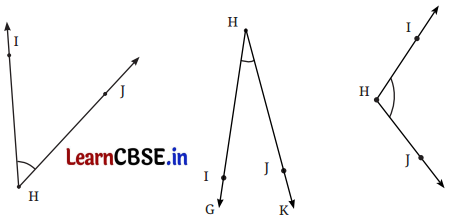
Solution:
(a) ∠IHJ = 47°
(b) ∠IHJ = 24°
(c) ∠IHJ =110°
Question 2.
Find the degree measures of different angles in your classroom using your protractor. .
Solution:
Angle at comer of blackboard = 90°
Angle at comer of desk = 90°
Question 3.
Find the degree measures for the angles given below. Check if your paper protractor can be used here!

Solution:
(a) ∠IHJ = 42°
(b) ∠IHJ =116°
Paper protractor cannot be used here.
Question 4.
How can you find the degree measure of the angle given below using a protractor?

Solution:
We require measure of reflex ∠AOB.
Step 1. We find measure of ∠AOB.
Step 2. We find 360° ∠AOB.
This is the required measure.
![]()
Question 5.
Measure and write the degree measures for each of the following angles:
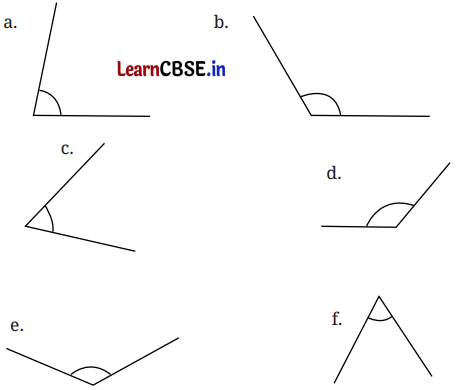
Solution:
(a) Measure of given angle is 80°
(b) Measure of given angle is 120°
(c) Measure of given angle is 60°
(d) Measure of given angle is 130°
(e) Measure of given angle is 130°
(f) Measure of given angle is 60°
Question 6.
Find the degree measures of ∠BXE, ∠CXE, ∠AXB and ∠BXC.

Solution:
(a) ∠BXE =115°
(b) ∠CXE = 85°
(c) ∠AXB = 65°
(d) ∠BXC = 30°
Question 7.
Find the degree measures of ∠PQR, ∠PQS and ∠PQT.

Solution:
(a) ∠PQR = 45°
(b) ∠PQS = 105°
(c) ∠PQT = 150°
Question 8.
Make the paper craft as per the given instructions. Then, unfold and open the paper fully. Draw lines on the creases made and measure the angles formed.

Solution:
Do it yourself.
Question 9.
Measure all three angles of the triangle shown in Fig. (a), and write the measures down near the respective angles. Now add up the three measures. What do you get? Do the same for the triangles in Fig. (b) and (c). Try it for other triangles as well, and then make a conjecture for what happens in general! We will come back to why this happens in a later year.

Solution:
∠A + ∠B + ∠C = 180°
![]()
2.9 Measuring Angles Figure it Out (Page No. 45-46)
Question 1.
Angles in a clock:
(a) The hands of a clock make different angles at different times. At 1 o’clock, the angle between the hands is 30°. Why?
(b) What will be the angle at 2 o’clock? And at 4 o’clock? 6 o’clock?
(c) Explore other angles made by the hands of a clock.

Solution:
(a) Numbers 1 to 12 are written along the circumference of a clock at equal distances.
360 ÷ 12 = 30.
Hence, angle between two consecutive numbers is 30°
At 1°’ clock hands are at 0 and 1 (consecutive numbers)
Hence angle between them is 30°.
(b) Angle between hands at 2 o’ clock = 2 × 30° = 60° angle between hands at 4 o’clock = 4 × 30°= 120°
Angle between hands at 6 o’ clock = 6 × 30°= 180°
(c) Angle between hands at 5 o’ clock = 5 × 30°= 150°
Angle between hands at 7 o’ clock = 7 × 30° = 210°
Angle between hands at 8 o’ clock = 8 × 30° = 240°
Question 2.
The angle of a door: Is it possible to express the amount by which a door is opened using an angle? What will be the vertex of the angle and what will be the arms of the angle?

Solution:
Yes, it is possible.

Here, vertex is B, and arms are AB and BC.
Question 3.
Vidya is enjoying her time on the swing. She notices that the greater the angle with which she starts the swinging, the greater is the speed she achieves on her swing. But where is the angle? Are you able to see any angle?

Solution:
Yes, an angle can be seen.

Question 4.
Here is a toy with slanting slabs attached to its sides; the greater the angles or slopes of the slabs, the faster the balls roll. Can angles be used to describe the slopes of the slabs?

Solution:
Greater the angle, greater the slope.
For each angle one arm is a side and one arm is the slope.

![]()
Question 5.
Observe the images below where there is an insect and its rotated version, fan angles be used to describe the amount of rotation? How? What will be the arms of the angle and the vertex?
Hint: Observe the horizontal line touching the insects.

Solution:
Both insects are rotated 90° clockwise.
2.10 Drawing Angles Figure it Out (Page No. 49-50)
Question 1.
In Fig. below, list all the angles possible. Did you find them all? Now, guess the measures of all the angles. Then, measure the angles with a protractor. Record all your numbers in a table. See how close your guesses are to the actual measures.

Solution:
The given figure has 20 angles.
Guess: ∠1 = ∠4 = 60°; ∠2 = ∠3 = 120° by actual measure: ∠1 = ∠4 = 70°; ∠2 = ∠3 = 110°.

Question 2.
Use a protractor to draw angles having the following degree measures:
(a)110°
(b) 40°
(c) 75°
(d)1120
(e) 134°
Solution:


Question 3.
Draw an angle whose degree measure is the same as the angle given below:

Also, write down the steps you followed to draw the angle.
Solution:
Step 1. Measure the given angle (∠IHJ = 120°)
Step 2. Using a protractor draw ∠ABC = 120°
2.11 Types of Angles and their Measures Figure it Out (Page No. 51-52)
Question 1.
In each of the below grids, join A to other grid points in the figure by a straight line lo get:
(a) An acute Angle

(b) An obtuse Angle

(c) A reflex Angle

Mark the intended angles with curves to specify the angles. One has been done for you.
Solution:

![]()
Question 2.
Use a protractor to find the measure of each angle. Then classify each angle as acute, obtuse, right, or reflex.
a. ∠PTR
b. ∠PTQ
c. ∠PTW
d. ∠WTP

Solution:
(a) ∠PTR = 300 acute
(b) ∠PTQ = 60° acute
(c) ∠PTW = 105° obtuse
(d) ∠WTP = 225° reflex
2.11 Types of Angles and their Measures Figure it Out (Page No. 53-54)
Question 1.
Draw angles with the following degree measures:
(a) 140°
(b) 82°
(c) 195°
(d) 70°
(e) 35°
Solution:

Question 2.
Estimate the size of each angle and then measure it with a protractor:

Classify these angles as acute, right, obtuse or reflex angles.
Solution:
(a) 45° acute
(b) 150° obtuse
(c) 120° obtuse
(d) 30° acute
(e) 95° obtuse
(f) 350° reflex
Question 3.
Make any figure with three acute angles, one right angle and two obtuse angles.
Solution:

Angles 1, 2 and 3 are acute angles, angle 4 is right angle, angles 5 and 6 are obtuse angles.
Question 4.
Draw the letter ‘M’such that the angles on the sides are 40° each and the angle in the middle is 60°.
Solution:

∠1 = 30°, ∠2 = 30°, ∠3 = 60°
Question 5.
Draw the letter ‘Y’ such that the three angles formed are 150°, 60° and 150°.
Solution:

∠1 = 150°, ∠2 = 60°, ∠3 = 150°
Question 6.
The Ashoka Chakra has 24 spokes. What is the degree measure of the angle between two spokes next to each other? What is the largest acute angle formed between two spokes?

Solution:
Angle between two consecutive spokes = 360 ÷ 24 = 15°
Largest acute angle = 5 × 15° = 75°

![]()
Question 7.
Puzzle: I am an acute angle. If you double my measure, you get an acute angle. If you triple my measure, you will get an acute angle again. If you quadruple (four times) my measure, you will get an acute angle yet again! But if you multiply my measure by 5, you will get an obtuse angle measure. What are the possibilities for my measure?
Solution:
Let the measure of the angle be m
Then 5 × m > 90 but 4 × m < 90
or m > \(\frac{90}{5}\) and m < \(\frac{90}{4}\)
Hence m > 18 but m < 22 ½
Hence measure of the angle is 19° or 20° or 21°